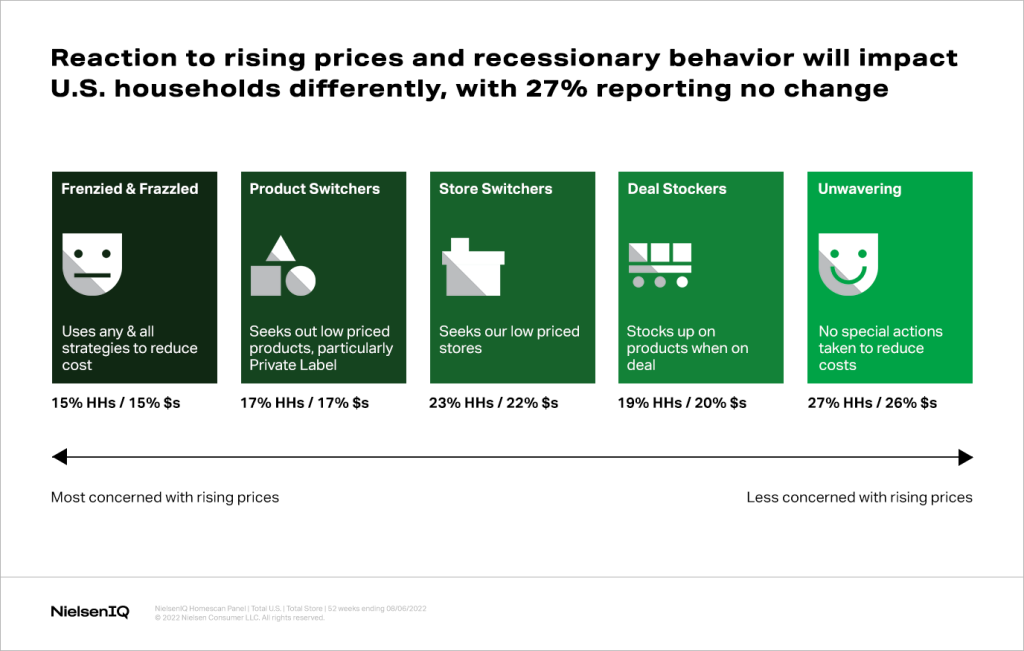Product innovation drives growth
What appeals to consumers? It’s the eternal question. Sure, a great product, strong branding—these are all important, but for brands that seek to hold consumers’ attention, these may not be enough.
This is especially so during times of crisis, which is what we unfortunately find ourselves living in right now. As global inflationary pressures persist, a vicious circle deepens: Consumer wallets are tightening, retailers are caught in tight financial binds, and manufacturers are scaling back their innovation agendas. But should they be?
NielsenIQ’s latest global analysis finds that innovation is a key driver of growth, and companies who hit the pause button risk getting left behind. In fact, companies who have continued to innovate during this challenging time are experiencing a greater share of growth, sales, and market share as compared with those who have not.
The last two years have been a challenge to navigate, but there are key actions manufacturers can take today to fortify their innovation pipelines, mitigate risk, and prepare for what comes next.


What is product innovation?
Product innovation is the business process of creating and introducing new or updated products to the market—often with the help of experts, analytics, and lots and lots of data. It’s also a business imperative that CPG companies need to grow and survive.
The impact of innovation
Product innovation—whether it be a new product, service, advancement, method, or process—can be daunting. Especially when the upfront cost of innovation does not promise any future rewards.
For businesses, it’s a natural tendency to stop spending, to focus on your core products when times get tough. The counter-intuitive approach—to invest during these difficult periods—might be more beneficial. Our data shows that brands that have embraced product innovation over the past several years have seen marked benefits, whereas those that have pulled back… not so much.
To find your way out of a crisis, sometimes you must innovate your way out. This isn’t a recent phenomenon either, some of the most common products we take for granted today became breakthrough innovations during difficult times. Take Dixie Cups during the Spanish Flu Pandemic of the early 20th century and Scotch Tape during The Great Depression, for example.
A recent study by McKinsey furthermore showed that historically, those that innovate not only survive these difficult periods, they are also more competitively positioned for the recovery.
So, it’s clear that product innovation needs to be top of mind for every brand right now. But where to begin?
Some caveats of course apply—supply-chain disruptions have made it difficult for brands to keep their core items on shelves. How can you innovate after all when you’re struggling to check this basic box?
The thing to remember is that product innovation doesn’t need to be revolutionary. Small innovations or renovations of existing products can keep your lines fresh and top of mind for consumers. Doing nothing will not get the job done.
The key phrase to remember is, “innovation with rationalization.” Retailers do not want unprofitable SKUs cluttering the shelf. You do not have the option of throwing a bunch of ideas against the wall, hoping one sticks. If retailers are more and more discerning, then you should be, too.
Why consumers want innovation
The question is, then, why are consumers so driven by product innovation? NielsenIQ data shows that over 2/3 of consumers today actively seek out innovative offerings, though regionally this can vary. Up to 57% of Brazilian consumers are excited to try new things, but German consumers prefer their routine, with 11% seldom trying new things, for example.
But in general, psychology comes into play. People like new things. A shiny “new!” sticker on a trusted face wash brand or a limited-time only, temporary addition from a favorite soft drink manufacturer will likely entice consumers to at least try them out.
The consumer inclination to try new things matches up nicely with retailers’ desire for new items to put on shelves that command a premium price. Again, it just has to be rational. The new product or innovation you are bringing to shelf must be carefully thought through and have a strong probability of success.
So, where do you start? NielsenIQ BASES has identified four actions you need to consider to make the most of your product innovation initiatives.
Assess your competitive brand position
To begin with, you need to take a look at your category and find where there is space for you to innovate. Furthermore, when it comes to thinking through your innovation process, consider the habits of your consumers by segment. While always important to do, this is especially critical in times of crisis.
Consider the following:
The Why
Understand category motivators in the most current context for your brand
The What
Uncover unmet needs and future trends that your brand can capture and own
The How
Deep dive into occasions and conversion triggers to help prioritize the most actionable findings
The chart below shows the five inflation segments in the U.S. and Canada that we’ve identified based on survey data as to how consumers respond to inflation.
Key takeaways here include that slightly over 73% of consumers in the U.S. and Canada are looking to save money. Keep this in mind when pricing, along with greater flexibility of consumers to hop from one brand to another and from one store to another. There is room to grab attention outside of your core group of consumers.

Keep your brand fresh through renovation
Instead of rolling out a new product, it may be more appropriate to proactively “renovate” your brand relying on your consumer, market and competitive learnings to focus your efforts. Don’t wait for a sales decline either to address these issues—by then, it’s likely too late.
For example, you could consider small enhancements that address consumer “pet peeves,” or revisit “old” ideas in light of new marketplace drivers.
It is also essential that you have a marketing plan in place that can effectively convey the importance of your renovation.
For example, when Bounty improved the performance of their paper towels by making them quilted, they launched an ad campaign touting all the new ways their product could be used. Consumers responded by boosting their usage, and sales increased not only for Bounty but for the paper towel category as a whole.

When thinking through your next product innovation, consider the following questions to help you align your product with the segment or segments you are targeting:
- How does the brand perform across engagement levels?
- What are the competitive opportunities and threats?
- What are the brand strengths and weaknesses?
- What are our areas of differentiation and path to growth?
- What can we learn from competition?
- How can occasion-led opportunities be leveraged to drive brand growth?
- What are the dimensions critical for brand success in the future?
Right-size your product innovation pipeline
Of course, inflationary pressure means that you need to shift resources around to ride out the storm. Your innovation portfolios must evolve during tough economic times rather than shut down or pull back, however.
Instead, you should focus resources (funds, people, and time) on what we call “Defenders”—product innovations that defend your brand, are short-term investments, and drive excitement among consumers.
Once economic pressures begin to ease, then you can start to diversify your bets and focus on what we call “Explorers” (new areas of growth you can capitalize on) and “Growers” (superstar product innovations)
Explorers
New areas of growth
Defenders
Short-term investments that drive excitement
Growers
Superstar product innovations
Explore new technologies and emerging trends
Rely on technology whenever you can to make your innovation development easier. Your R&D teams can use AI-driven solutions to help you target optimal innovation pathways, for example.
It’s also essential to have your ear to the ground and stay on top of emerging trends. Sustainability practices in product development and packaging can help differentiate your company and win consumer goodwill.
You should also be aware that newer retail channels like e-commerce and the direct-to-consumer (DTC) model can disrupt your market access. More products launch online than in physical stores, but online launches are half as likely to enter year two with steady sales. This speaks to the challenges of this marketplace, where if you are not featured on page one of a retailer’s website, your odds of success are low.
Bold innovators win
The key to a successful product innovation pipeline is to find opportunity within your present capabilities. In these challenging times, you don’t have to create something new from scratch. See what quick yet beneficial changes you can make that will resonate with your consumers, and plan accordingly. From product development to marketing and execution, your organization needs to be aligned to make the most of your innovation efforts.
By doing so, you can not only survive this period of crisis, but thrive.

Want to learn more?
Get more insights from BASES experts in our upcoming webinar, “The Innovator’s Guide to Success in Inflationary Times.”
Stay ahead by staying in the loop.
Don’t miss the latest insights, offerings, and opportunities from NIQ BASES
By clicking on sign up, you agree to our privacy statement and terms of use.


![Understanding your audience: The power of segmentation in retail [podcast]](https://nielseniq.com/wp-content/uploads/sites/4/2025/07/Podcast-Understanding_your_audience-The_power_of_segmentation_in_retail-mirrored.jpg?w=1024)
